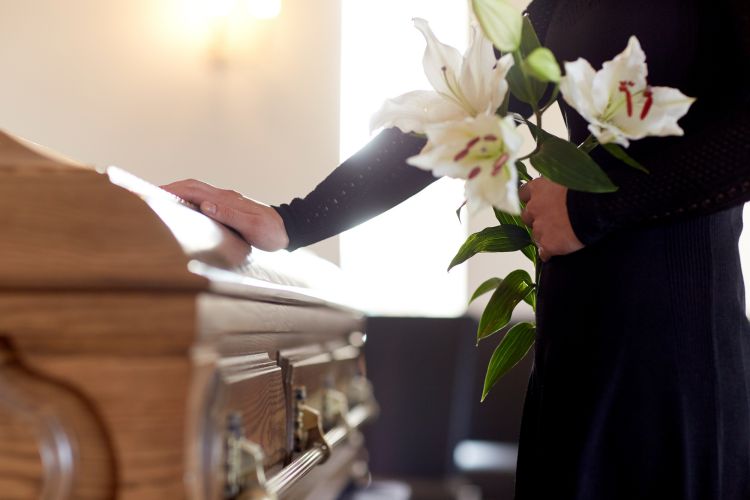
Grief is a deeply personal journey. The air feels thin, and the ground seems unsteady. Saying goodbye to a loved one is a storm in your soul, a tide of emotions pulling you under. But even in the deepest currents, there’s a glimmer of choice—a chance to navigate the waves of grief with purpose.
When it comes to funerals, you’ll likely encounter various options and traditions. Don’t feel overwhelmed, though—the key lies in understanding what resonates most with you and your loved one.
This guide outlines six different funeral types, each with its unique characteristics and considerations. So, take a deep breath, gather your thoughts, and let’s explore these choices with clarity and empathy.
Table of Contents
1. Traditional Funeral
A traditional funeral offers a familiar and structured framework for honoring your loved one. It begins with a viewing or visitation, providing space for friends and family to pay their respects and offer condolences.
The heart of the ceremony lies in the formal service, often held at a place of worship or funeral home. Here, hymns and prayers provide comfort and solace, while eulogies and readings celebrate the life lived and offer a sense of closure.
Finally, the graveside committal marks the physical act of saying goodbye, though the memory and impact of your loved one live on. If you seek a traditional and dignified farewell, this time-honored ceremony offers a comforting path through grief and remembrance.
2. Memorial Service
For those seeking a less formal and traditional approach to honoring a loved one, the memorial service offers a unique and personal alternative. Unlike a traditional funeral with its emphasis on mourning, a memorial service centers on celebrating the life lived.
During a memorial service, the deceased’s presence is often acknowledged through photos, mementos, or even a symbolic urn. The ceremony itself can be structured to reflect the deceased’s personality and interests.
You can choose readings from their favorite poems or books, share stories and anecdotes, or even incorporate music or activities they enjoyed. This flexibility allows you to create a truly personalized experience that resonates with your family and friends.
3. Celebration Of Life
The Celebration of Life ceremony offers a vibrant, non-religious approach to honoring your loved one. Instead of focusing on somber mourning, this option emphasizes joyful remembrance through shared memories and positive anecdotes.
Laughter and celebration take the spotlight, often accompanied by music, vivacious floral arrangements, food, and activities inspired by the deceased’s passions. Imagine a gathering filled with music that sparked their joy, food they cherished, or even activities they loved.
This vibrant ceremony allows you to not only mourn their loss but also celebrate the impact they had on your life and the world around them.
4. Natural Burial
If you’re seeking a return to nature for your loved one, a natural burial might be your best option. This eco-friendly ceremony prioritizes the decomposition process, allowing the body to seamlessly reintegrate back into the earth.
Embalming chemicals are eschewed, and the deceased is laid to rest in a biodegradable casket or shroud placed directly in the soil. This eliminates the need for concrete vaults and minimizes environmental impact.
The simplicity of a natural burial fosters a sense of connection with the natural world, offering a peaceful and sustainable way to honor your loved one’s memory.

5. Green Burial
Green burial offers a sustainable approach to laying your loved one to rest. While similar to natural burial in its eco-conscious principles, it allows for greater flexibility.
You can choose a biodegradable casket or shroud, often made from materials like wicker or bamboo, and opt for a cemetery dedicated to green practices. These cemeteries adhere to specific regulations, ensuring minimal environmental impact.
For instance, embalming chemicals are avoided, and vaults—traditionally concrete structures surrounding the casket—aren’t permitted. This approach allows the body to naturally decompose and nourish the surrounding soil, creating a lasting connection with nature.
Consider green burial if environmental responsibility and a simpler, earth-honoring ceremony resonate with you and your loved one.
6. Direct Cremation
If efficiency and swiftness resonate with you, direct cremation offers a straightforward path. Following the cremation process, the ashes are returned to your family without a formal ceremony. This option minimizes logistical complexities and allows you the freedom to determine how to honor your loved one’s memory at your own pace.
You can choose to scatter the ashes in a meaningful location, place them in an urn for safekeeping, or even enter them in a cemetery. Direct cremation provides a dignified and economical approach to final disposition. This lets you focus on personal reflection and healing.
Parting Thoughts
There’s no right or wrong way to say goodbye. Choose the option that feels most comfortable and meaningful for you, your family, and your loved one. Take your time, ask questions, and let your heart guide you through this difficult yet important decision. You’ll find the perfect way to celebrate a life well-lived and traverse the path of grief with love and remembrance.






